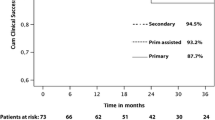Abstract
Although endovascular therapy (EVT) has been widely used for iliac lesions due to acceptable patency with stenting, EVT has not been established as primary treatment for aortic occlusion, partly because of uncertainty regarding long-term results. The purpose of this study was to investigate outcomes following EVT with stenting for chronic aortic occlusion. This study was a single-center retrospective analysis of a prospectively maintained database. Between September 2005 and May 2012, twenty-four lesions from 25 patients with a clinical diagnosis of chronic aortic occlusion (mean age, 71 years; 80 % male) were treated with EVT with stenting. Kaplan–Meier estimators were used to determine the patency rates according to Society for Vascular Surgery criteria. In results, lesion type was Trans Atlantic Inter-Society Consensus D in all patients. Mean lesion length was 145 mm. Initial success rate and procedural complication rate were 96 % (24/25) and 8 % (2/25), respectively. At 36 months, primary and secondary patency rates were 76 and 94 %, respectively. Restenosis was observed in 5 patients, all of whom underwent reintervention (four successful, one failure and intensity of medical treatment). EVT can be safely done in patients with chronic aortic occlusion. Procedural morbidity and mid-term durability were comparable to those of bypass surgery up to 3 years.


Similar content being viewed by others
References
Leriche R, Morel A. The syndrome of thrombotic obliteration of the aortic bifurcation. Ann Surg. 1948;127:193–206.
Norgren L, Hiatt WR, Dormandy JA, Nehler MR, Hariss KA, Fowkes FG. TASC II Working Group Inter-Society Consensus for the Management of Peripheral Arterial Disease (TASC II). J Vasc Surg 2007;45(Suppl S):S5–S67.
Leville CD, Kashyap VS, Clair DG, Bena JF, Lyden SP, Greenberg RK, et al. Endovascular management of iliac artery occlusions: extending treatment to TransAtlantic Inter-Society Consensus class C and D patients. J Vasc Surg. 2006;33:32–9.
Tsetis D, Uberoi R. Quality improvement guidelines for endovascular treatment of iliac artery occlusive disease. Cardiovasc Intervent Radiol. 2008;31:238–45.
Pulli R, Dorigo W, Fargion A, Innocenti AA, Pratesi G, Marek J, et al. Early and long-term comparison of endovascular treatment of iliac artery occlusions and stenosis. J Vasc Surg. 2011;53:92–8.
Scheinert D, Schroder M, Balzer J, Steinkamp H, Biamino G. Stent-supported reconstruction of the aortoiliac bifurcation with the kissing balloon technique. Circulation. 1999;100:295–300.
Nyman U, Uher P, Lindh M, Lindblad B, Ivancev K. Primary stenting in infrarenal aortic occlusive disease. Cardiovasc Intervent Radiol. 2000;23:97–108.
Rosset E, Malikov S, Magnan PE, Poirier M, Valerio N, Ede B, et al. Endovascular treatment of occlusive lesions in the distal aorta: mid-term results in a series of 31 consecutive patients. Ann Vasc Surg. 2001;15:140–7.
Yilmaz S, Sindel T, Golbasi I, Turkay C, Mete A, Luleci E. Aortoiliac kissing stents: long-term results and analysis of risk factors affecting patency. J Endovasc Ther. 2006;13:291–301.
Klonaris C, Katsargyris A, Tsekoulaos N, Alexandrou A, Giannopoulos A, Bastounis E. Primary stenting for aortic lesions: from single stenoses to total aortoiliac occlusions. J Vasc Surg. 2008;47:310–7.
Bjorses K, Ivancev K, Riva L, Manjer J, Uher P, Resch T. Kissing stents in the aortic bifurcation—a valid reconstruction for aorto-iliac occlusive disease. Eur J Vasc Endovasc Surg. 2008;36:424–31.
Krankenberg H, Schuluter M, Schwencke C, Walter D, Pascotto A, Sandstede J, et al. Endovascular reconstruction of the aortic bifurcation in patients with Leriche syndrome. Clin Res Cardiol. 2009;98:657–64.
Sharafuddin MJ, Hoballah JJ, Kresowik TF, Sharp WJ, Golzarian J, Corson JD, et al. Long-term outcome following stent reconstruction of the aortic bifurcation and the role of geometric determinants. Ann Vasc Surg. 2008;22:346–57.
Moise MA, Alvarez-Tostado JA, Clair DG, Greenberg RK, Lyden SP, Kashyap VS, et al. Endovascular management of chronic infrarenal aortic occlusion. J Endovasc Ther. 2009;16:84–92.
Jongkind V, Akkersdijk G, Yeung K, Wisselink W. A systemic review of endovascular treatment of extensive aortoiliac occlusive disease. J Vasc Surg. 2010;52:1376–83.
Kim T, Ko Y, Kim U, Kim J, Choi D, Hong M, et al. Outcomes of endovascular treatment of chronic total occlusion of the infrarenal aorta. J Vasc Surg. 2011;53:1542–9.
Kashyap VS, Pavkov ML, Bena JF, Sarac TP, Lyden SP, Clair DG, et al. The management of severe aortoiliac occlusive disease: endovascular therapy rivals open reconstruction. J Vasc Surg. 2008;48:1451–7.
Hans SS, Desantis D, Siddiqui R, Khoury M. Results of endovascular therapy and aortobifemoral grafting for Transatlantic Inter-society type C and D aortoiliac occlusive disease. Surgery. 2008;144:583–90.
Burke CR, Henke PK, Hernandez R, Rectenwald JE, Krishnamurthy V, Englesbe MJ, et al. A contemporary comparison of aortofemoral bypass and aortoiliac stenting in the treatment of aortoiliac occlusive disease. Ann Vasc Surg. 2010;24:4–13.
Rutherford RB, Baker JD, Ernst C, Johnston KW, Porter JM, Ahn S, et al. Recommended standards for reports dealing with lower extremity ischemia: revised version. J Vasc Surg. 1997;26:517–38.
Fontcuberta J, Flores A, Langsfeld M, Orgaz A, Cuena R, Criado E, et al. Screening algorithm for aortoiliac occlusive disease using duplex ultrasonography-acquired velocity spectra from the distal external iliac artery. Vascular. 2005;13:164–72.
Shaalan WE, French-Sherry E, Castilla M, Lozanski L, Bassiouny HS. Reliability of common femoral artery hemodynamics in assessing the severity of aortoiliac inflow disease. J Vasc Surg. 2003;37:960–9.
Spronk S, den Hoed PT, de Jonge LC, van Dijk LC, Pattynama PM. Value of the duplex waveform at the common femoral artery for diagnosing obstructive aortoiliac disease. J Vasc Surg. 2005;42:236–42.
De Vries SO, Hunink MGM. Results of aortic bifurcation grafts for aortoiliac occlusive disease: a meta-analysis. J Vasc Surg. 1997;26:558–69.
Martin D, Katz SG. Axillofemoral bypass for aortoiliac occlusive disease. Am J Surg. 2000;180:100–3.
Hertzer NR, Bena JF, Karafa MT. A personal experience with direct reconstruction and extra-anatomic bypass for aortoiliofemoral occlusive disease. J Vasc Surg. 2007;45:527–35.
West CA Jr, Johnson LW, Doucet L, Caldito G, Heldman M, Carson S, et al. A contemporary experience of open aortic reconstruction in patients with chronic atherosclerotic occlusion of the abdominal aorta. J Vasc Surg. 2010;52:1164–72.
Sabri SS, Choudhri A, Orgera G, Arslan B, Turba UC, Harthun NL, et al. Outcomes of covered kissing stent placement compared with bare metal stent placement in the treatment of atherosclerotic occlusive disease at the aortic bifurcation. J Vasc Interv Radiol. 2010;21:995–1003.
Mwipatayi BP, Thomas S, Wong J, Temple S, Vijayan V, Jackson M, et al. A comparison of covered vs bare expandable stents for the treatment of aortoiliac occlusive disease. J Vasc Surg. 2011;54:1561–70.
Mii S, Eguchi D. Comparison of axillobifemoral and aortobifemoral bypass for aorto-bilateral iliac occlusive disease. Jpn J Vasc Surg. 2005;14:7–12.
Conflict of interest
None.
Author information
Authors and Affiliations
Corresponding author
Rights and permissions
About this article
Cite this article
Dohi, T., Iida, O., Okamoto, S. et al. Mid-term clinical outcome following endovascular therapy in patients with chronic aortic occlusion. Cardiovasc Interv and Ther 28, 327–332 (2013). https://doi.org/10.1007/s12928-013-0173-0
Received:
Accepted:
Published:
Issue Date:
DOI: https://doi.org/10.1007/s12928-013-0173-0




